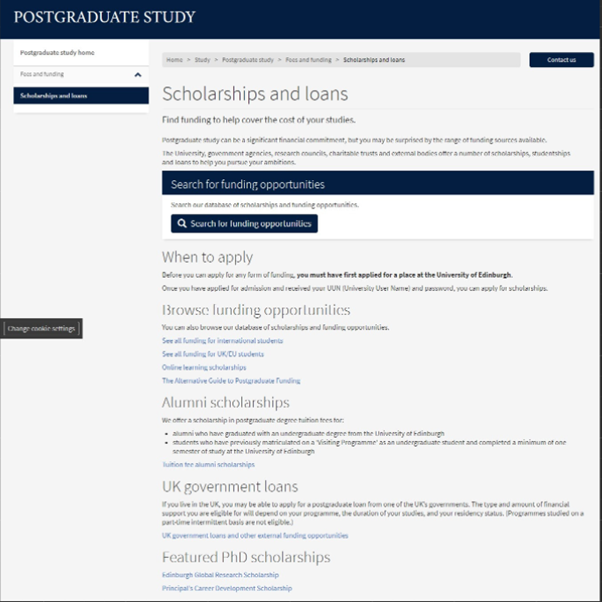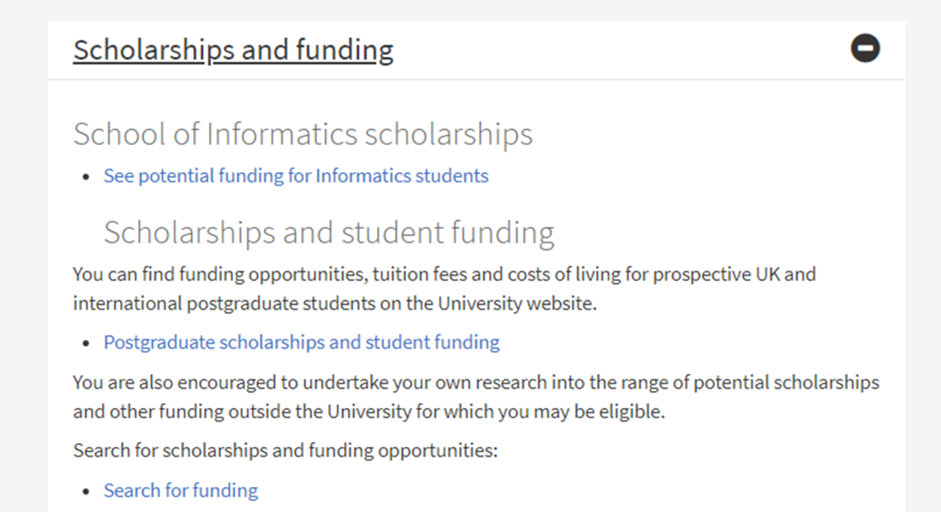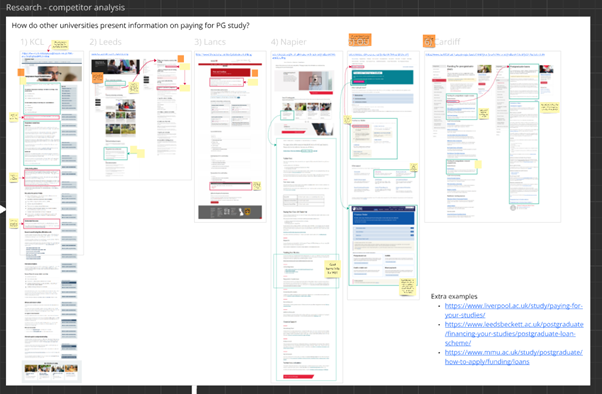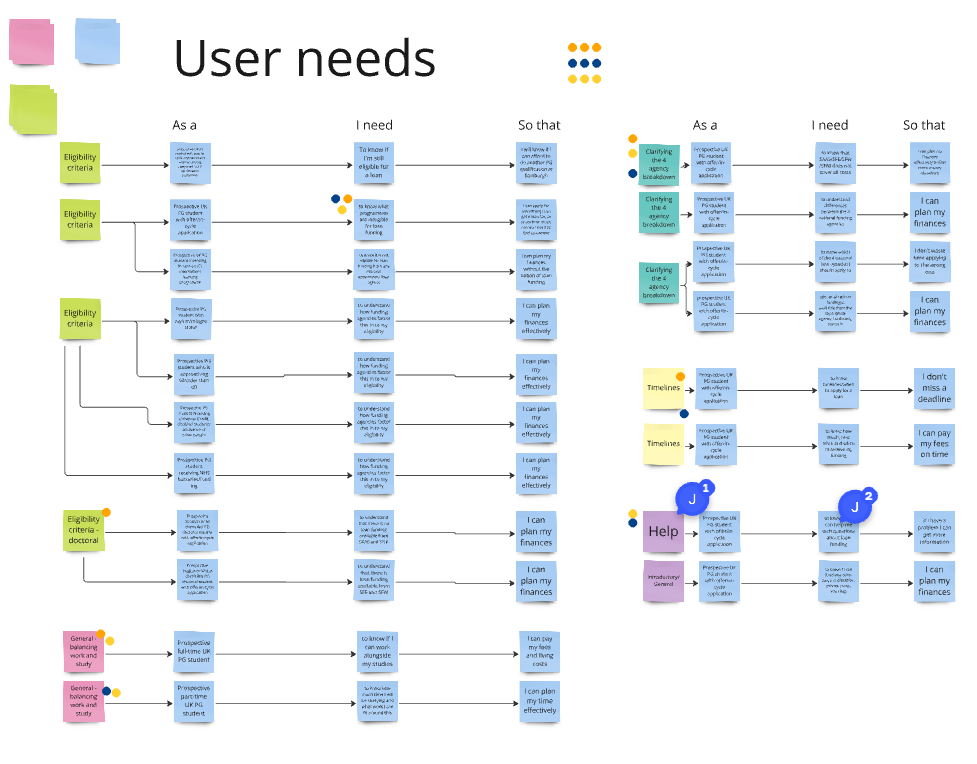Defining the scope: Background, research and user needs
This blog is part of a series on a mini-project the Content Operations team completed in August and September 2024.
In this instalment, we will talk about the project background, research, and user needs.
For more information on the other stages of this project, see our individual blogs:
- Improving student understanding of postgraduate funding and UK government loans: a Content Operations mini-project
- Right information, right place: Channel mapping and content drafting
- Lessons learned from usability testing under time pressure
The background to this project
We were approached by Ewan Fairweather, Student Recruitment Manager in SRA who wanted to consider how we could better prepare prospective students for the full cost of university.
Ewan had anecdotal evidence from sessions with prospective students, applicants, and even offer-holders where the audience was still not sure how they were going to fund their studies a few weeks out from starting.
This isn’t a problem that is unique to Edinburgh, it is an issue across the sector – Universities are often vague about the true funding requirements for postgraduate study:
The sector is still struggling to explain the costs of higher education
Aims of the project
We held an initial kick-off meeting with Ewan to establish the aims of this project.
With the majority of UK students using a UK Government loan to help towards funding their postgraduate studies, our UK audience was where we felt we could make the biggest impact in the short period of time we had to work on this project.
We did a scooping activity to prioritise areas we had time to make an impact on and areas we’d like to look into if we get the chance. Due to time constraints, outside the scope of this project were the international market (non-UK students) and PGR programmes.
Our aim for the project would be to provide clearer, more consistent and more visible information on UK government agency loan funding (from SAAS, SFE, SFW and SFNI) and the crucial differences across these four funding bodies based on PG study level, duration, mode and residency.
The first steps
After we had established the aims for this project, it was time to start the research phase of the project. We split up the areas to research into two areas; current University of Edinburgh content and other universities who provided similar content.
After we identified areas to work on from the research phase of the project, we would then look at developing some user stories to make sure we are addressing our end-users intentions, goals and needs.
Ewan and Jen also engaged with key stakeholders to ensure they could feed into the project and were aware of the work going on.
Research
We split the research among the three team members in the content operations team – Jen and Louis reviewed the current ed.ac.uk content and Cathy looked into how other institutions present their loan information.
To collect and present our findings from the research phase, we used a Miro board. It’s a great tool for collaborating remotely and it’s very flexible. It essentially works like a whiteboard or a noticeboard where you can drop comments and images. It was perfect for our needs for this project.
Existing ed.ac.uk content
We wanted to find out what we actually said about sources of funding and the full financial cost of study.
We had lots of information on fees and finance, a new section launched this year on the average cost of living in Edinburgh (for on-campus students), and lots of information on Scholarships. But our data told us that actually, a lot more students rely on a combination of funding to piece together the financial puzzle. And in fact, a lot of UK students were making use of postgraduate loans from UK government agencies.
Postgraduate study site
From our review of the Postgraduate study site, it was clear there was an imbalance between how much information we provided about scholarships compared with loans.
On the ‘Scholarships and loans’ page, we only included a small section about UK Government loans at the bottom of the page, with the majority of this page prioritising scholarship information.
The reality of how most students fund their studies through a combination of sources wasn’t clearly outlined within this section.

A screenshot of the old Scholarships and loans web page.
Scholarships and student funding site
After reviewing the content from the Scholarship and student funding site it was clear they had prioritised one source of funding, scholarships. This imbalance with our content creates an unrealistic expectation that scholarships are plentiful and will pay for all of your postgraduate study costs, including living expenses.
Previously from the postgraduate study site, we linked off to two pages (‘Funding for UK students’ and ‘UK Government and other external funding’) on the Scholarships and student funding site for users to find out more information about how to fund their studies.
Funding for UK students
This overview page prioritises pages that link to scholarship information and doesn’t use the term loan anywhere on the page. Finding information about UK Government loans isn’t clear or easy for users to find.
UK Government and other external funding
This page was linked to from our ‘UK government loans’ section and the relevant pages within this section for users wanting to learn about UK Government loans were out of date.
We’d already determined this content was out of scope as our focus was on the loans side, but we felt it was important to understand all the information that is provided across the university web estate.
Degree finder
When we looked across what schools have included within the ‘Scholarships and funding’ section there was a lack of information about loans and other sources of funding other than scholarships. This section was mainly used for listing scholarships and linking to the scholarships site without giving any real context about the entire funding picture.

A screenshot of an example scholarships and funding section on the postgraduate degree finder from last year.
It was clear the content within the ‘Scholarships and funding’ section wasn’t doing a good job of illustrating that the majority of students will need to use a combination of funding sources and cannot just rely on getting a scholarship to fund their fees and living costs.
What our competitors do
Again, our helpful colleague Ewan was here to provide us with a lot of starting points. He was able to point us to the handful of universities that were more open about other sources of funding like loans, grants and working while studying.
The rest of the research revealed though that actually, most universities were a lot like us – lots of mention of scholarships, not so much on practical tools and funding streams that actual students are using now.

Examples of the PG loans information provided by other institutions on our Miro project board.
Other universities
- Several other unis distinguish between different sources of funding, such as:
- loans
- scholarships
- other sources of funding (grants, income from PT work, etc)
- One uni categorised sources of funding by:
- PGT (gov taught masters loans, uni master’s scholarships)
- PGR (gov doctoral loans, uni PhD scholarships)
- Additional funding options (charity grants, income from PT work)
- One uni provides a ‘Finance finder’: webform with conditional reveals; results returned are based on form responses (Open University: Finance finder)
- Most other unis provided detailed info on UK gov postgrad loans for ‘home students’, which we were lacking on our PG Study site
User needs
To focus on our end-users we needed to develop user stories based on our research. User stories help us prioritise the end-user’s intentions, goals, and needs. It can also help you to break down complex problems into smaller, achievable tasks.
Based on our research we identified a number of things that our content didn’t cover, including:
- Overall picture of how students fund their studies (combination funding)
- General picture of how the UK loans system works
- Programmes ineligible for UK loans
- General advice on work-while-you-study – part-time and full-time differences
Alongside our research, Ewan also pulled together first-hand evidence from sessions with prospective students, applicants, and offer holders. A lot of this evidence was quickly developed into user stories.

An example of the format we used for our user stories. As a.. I need.. So that..
Based on our research, we developed a list of user needs both for prospective students and from the perspective of us as a university.
Some of these statements were very specific, for example:
As a prospective doctoral postgraduate student based in Scotland
I need to know if I can get a loan from SAAS for my studies (you can’t)
So that I can budget and plan my finances
Others were less clearly defined but contributed to the type of picture we were trying to draw for our prospective students.

All of the user needs we collected on our Miro board.
Prioritising our user stories
With Ewan’s help, we developed 21 user stories. To prioritise which user stories we felt were the most important and what we would take forward to the next stage of the project, we used dot voting to vote on user stories we wanted to discuss as a group. Dot voting is a democratic decision-making and prioritising tool we use as a team.
Dot Voting: A Simple Decision-Making and Prioritizing Technique in UX
Stakeholder management
We took these user needs as voted on, and selected the top ones we knew we could tackle. We then took this back to our stakeholder list for comments to ensure we aligned with what they thought was a key user or business requirement. Thankfully, they were.
Next up – Channel mapping and content drafting
The project’s next phase involved drafting the content for the degree finder and the postgraduate study site. Read about the next stage of the project:
Right information, right place: Channel mapping and content drafting



